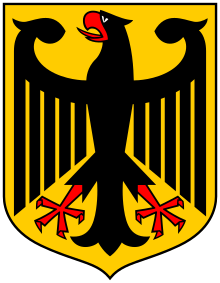 Global Information
Global InformationCoat of arms of Germany information
| Federal coat of arms of Germany | |
|---|---|
 | |
| Versions | |
 Version (Bundesschild) used on the German state flag and military standards | |
| Armiger | Federal Republic of Germany |
| Adopted | 20 January 1950 |
| Shield | Or, an eagle displayed sable armed beaked and langued gules |
The coat of arms of Germany displays a black eagle with a red beak, a red tongue and red feet on a golden field, which is blazoned: Or, an eagle displayed sable beaked langued and membered gules. This is the Bundesadler (German for "Federal Eagle"), formerly known as Reichsadler (German: [ˈʁaɪ̯çsˌʔaːdlɐ] ⓘ, German for "Imperial Eagle"). It is one of the oldest coats of arms in the world, and today the oldest national symbol used in Europe.
It is a re-introduction of the coat of arms of the Weimar Republic (in use 1919–1935), which was adopted by the Federal Republic of Germany in 1950.[1] The current official design is due to Karl-Tobias Schwab (1887–1967) and was originally introduced in 1928.
The German Empire of 1871–1918 had re-introduced the medieval coat of arms of the Holy Roman Emperors, in use during the 13th and 14th centuries (a black single-headed eagle on a golden background), before the emperors adopted the double-headed eagle, beginning with Sigismund of Luxemburg in 1433. The single-headed Prussian Eagle (on a white background; blazoned: Argent, an eagle displayed sable) was used as an escutcheon to represent the Prussian kings as dynasts of the German Empire. The Weimar Republic introduced a version in which the escutcheon and other monarchical symbols were removed.
The Federal Republic of Germany adopted the Weimar eagle as its symbol in 1950. Since then, it has been known as the Bundesadler ("federal eagle"). The legal basis of the use of this coat of arms is the announcement by President Theodor Heuss, Chancellor Konrad Adenauer and Interior Minister Gustav Heinemann of 20 January 1950, which is word for word identical to the announcement by President Friedrich Ebert and Interior Minister Erich Koch-Weser by 11 November 1919:
By reason of a decision of the Federal Government I hereby announce that the Federal coat of arms on a gold-yellow shield shows the one headed black eagle, the head turned to the right, the wings open but with closed feathering, beak, tongue and claws of red color. If the Federal Eagle is shown without a frame, the same charge and colors as those of the eagle of the Federal coat of arms are to be used, but the tops of the feathers are directed outside. The patterns kept by the Federal Ministry of the Interior are definitive for the heraldic design. The artistic design is reserved to each special purpose.
— The Federal President Theodor Heuß, The Federal Chancellor Adenauer, The Federal Minister of the Interior Heinemann, Announcement concerning the federal coat of arms and the federal eagle.[2]
Since the accession (1990) of the states that used to form the German Democratic Republic, the Federal Eagle has been the symbol of the reunified Germany.
Official depictions of the eagle can be found not only in the federal coat of arms but also on the federal institutions flag, the standard of the president of Germany and official seals. These are designs by various artists of the Weimar period and differ primarily in the shape and position of the wings. A large and rather plump version of the eagle decorates the chamber of the Bundestag, the German parliament; it is sometimes called Fette Henne ("Fat Hen"), with a similar representation found on the German euro coins. In addition to the official depictions, artistic renderings of the federal eagle are permitted and have found their way onto coins, stamps and the letterhead of federal authorities. In 1997 the Federal Press Office implemented a slightly simplified version of the original von Weech seal design which has since been used as a corporate design of the Federal government especially for publications and media appearances. It has no official status though as it is not mentioned in any ordinance or shown in the binding patterns of 1952 still in effect.[3]
| Variants employed by institutions | ||||
|---|---|---|---|---|

|

|

|

|

|
| Bundestag | Bundesrat | President | Cabinet | Federal Constitutional Court |
- ^ Bekanntmachung betreffend das Bundeswappen und den Bundesadler (Proclamation on the Federal Coat-of-Arms and the Federal Eagle), published 20 January 1950, in the Bundesgesetzblatt I 1950, p. 26, and Bekanntmachung über die farbige Darstellung des Bundeswappens (Proclamation on the Coloured Representation of the Federal Coat-of-Arms), published 4 July 1952 in the Bundesanzeiger № 169, 2 September 1952.
- ^ Heuss, Theodor; Adenauer, Konrad; Heinemann, Gustav (20 January 1950), Bekanntmachung betreffend das Bundeswappen und den Bundesadler [Announcement concerning the federal coat of arms and the federal eagle], Bonn
{{citation}}: CS1 maint: location missing publisher (link) - ^ Walter J. Schütz: Die Republik und ihr Adler. Staatliche Formgebung von Weimar bis heute, in: Christian Welzbacher (ed.): Der Reichskunstwart. Kulturpolitik und Staatsinszenierung in der Weimarer Republik 1918-1933, Weimar 2010, pp. 116–135, here pp. 133-134.


